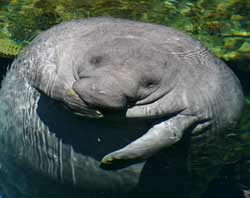
Most groups are temporary associations, without regard to sex or age.

Manatees are not territorial and do not observe any social hierarchy. The areas inhabited by this species have fairly constant temperatures year-round and an abundant food source, and without the need for group foraging techniques or group defence, this species is largely solitary, occasionally forming loose aggregations.

When resting, manatees have been known to stay submerged for up to 20 minutes. When manatees are using a great deal of energy, they may surface to breathe as often as every 30 seconds. They may rest submerged at the bottom or just below the surface, coming up to breathe on the average of every three to five minutes. They graze for food along water bottoms and on the surface. The other subspecies of the West Indian manatee is sometimes referred to as a Caribbean/Antillean manatee (Trichechus manatus manatus). The Florida manatee (Trichechus manatus latirostris) is a subspecies of the West Indian manatee. It is believed they can live 60 years or more. The West Indian sea cow has evolved in areas with no natural predators and as a result the members of this species have had no need to develop complex behaviours for predator avoidance. They can consume 10-15% of their body weight daily in vegetation. Manatees feed primarily on sea grasses and sometimes, on small invertebrates. Most of their time is spent eating, resting, and in travel. The manatee can grow up to four metres (13 feet) long and weighs between 362-544 kilograms (800-1,200 pounds). The West Indian manatee is related to the West African manatee, the Amazonian manatee, the dugong, and to the Steller's sea cow, which was hunted to extinction in 1768. Manatees are believed to have evolved from a wading, plant-eating animal. The manatee's closest land relatives are the elephant and the hyrax, a small, gopher-sized mammal.

Their head and face are wrinkled with whiskers on the snout. They have two forelimbs, called flippers, with three to four nails. West Indian manatees are large, gray aquatic mammals with bodies that taper to a flat, paddle-shaped tail. The manatee is classified as an Environmentally Sensitive Species in Trinidad and Tobago. Trichechus manatus (West Indian Manatee/ Sea Cow)


 0 kommentar(er)
0 kommentar(er)
